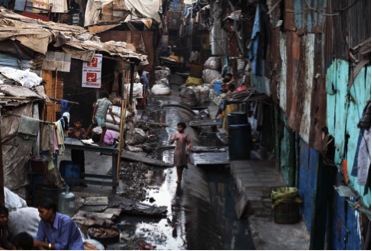Dharavi and My Movement away from Pity
 “Keep moving. Don’t interrupt the flow,” Our tour guide from Reality Tours explained us too many times during our tour through Dharavi, the largest slum in Asia. With over one million residents working, playing, and moving about in the one square mile neighborhood in central Mumbai, my first reaction was to withdraw from it all—the people, the decrepit buildings, and coating of filth and trash that covered most of the roads (and a few of the less-than-vertical walls). I became intensely focused on where I moved my arms and placed my feet so that I could avoid touching anything that looked dirty and prevent myself from stepping in the muddy patches of the narrow alleyways. Most of the time I was able to stand up straight, but sometimes I had to stoop as we walked to avoid the wires running along the thinnest of spaces in between buildings where we could only pass one at a time. But, regardless of the tight quarters and uneven paths, we had to keep moving to prevent ourselves from being too much of a nuisance for the people bustling about in the nice weather.
“Keep moving. Don’t interrupt the flow,” Our tour guide from Reality Tours explained us too many times during our tour through Dharavi, the largest slum in Asia. With over one million residents working, playing, and moving about in the one square mile neighborhood in central Mumbai, my first reaction was to withdraw from it all—the people, the decrepit buildings, and coating of filth and trash that covered most of the roads (and a few of the less-than-vertical walls). I became intensely focused on where I moved my arms and placed my feet so that I could avoid touching anything that looked dirty and prevent myself from stepping in the muddy patches of the narrow alleyways. Most of the time I was able to stand up straight, but sometimes I had to stoop as we walked to avoid the wires running along the thinnest of spaces in between buildings where we could only pass one at a time. But, regardless of the tight quarters and uneven paths, we had to keep moving to prevent ourselves from being too much of a nuisance for the people bustling about in the nice weather.
 It is the beginning of the rainy season, so there should have been more mud and less fun, but since it had been a couple of days since the last big rain, every so often children would be playing cricket in the few open areas—wicket substituted for a broken plastic lawn chair. The sun had also baked the ground hard enough to prevent men from being stalled as they went about their business, be it cleaning and refurbishing old cans of cooking oil, recycling plastics (a very long process which produces millions of tiny pellets), or forming leather. Women, most wearing either bindis or burquas, washed clothes and made papadums (like tortillas) in the streets.
It is the beginning of the rainy season, so there should have been more mud and less fun, but since it had been a couple of days since the last big rain, every so often children would be playing cricket in the few open areas—wicket substituted for a broken plastic lawn chair. The sun had also baked the ground hard enough to prevent men from being stalled as they went about their business, be it cleaning and refurbishing old cans of cooking oil, recycling plastics (a very long process which produces millions of tiny pellets), or forming leather. Women, most wearing either bindis or burquas, washed clothes and made papadums (like tortillas) in the streets.
I was surprised. I had braced myself for utter desperation similar to that described in the opening scene of Oedipus Rex—supplicants lying in various positions of despair. For all I had read about the economy and industry of the slum, I regret to say that I think I was prepared to feel pity. What I saw seemed very far from the truth. People were working hard to get ahead in life. I came away from the slum feeling the pride of its people.
Yes, our tour guide had grimly pointed out that the conditions of the slum create thousands of cases of jaundice, cholera, and tuberculosis every year. He said this along with mentioning that the lives of the people whose job it is to clean paint cans by burning their contents away are only a part of the many that are shortened in search of steady income. Our tour guide had said much about the negative in Dharavi, but he only said it in isolated instances that were bookended by his many jokes.
Dharavi needs a lot of work, but it does not need pity. I do not think that pity is ever an emotion that should be used to describe another’s life because they live in poverty. That can make it seem as if by virtue of having running water twenty-four hours a day, my life is better than someone’s who does not. I now do not think that a household income can be an accurate measure of happiness, and I hope that I do not make that mistake again.
--Michael